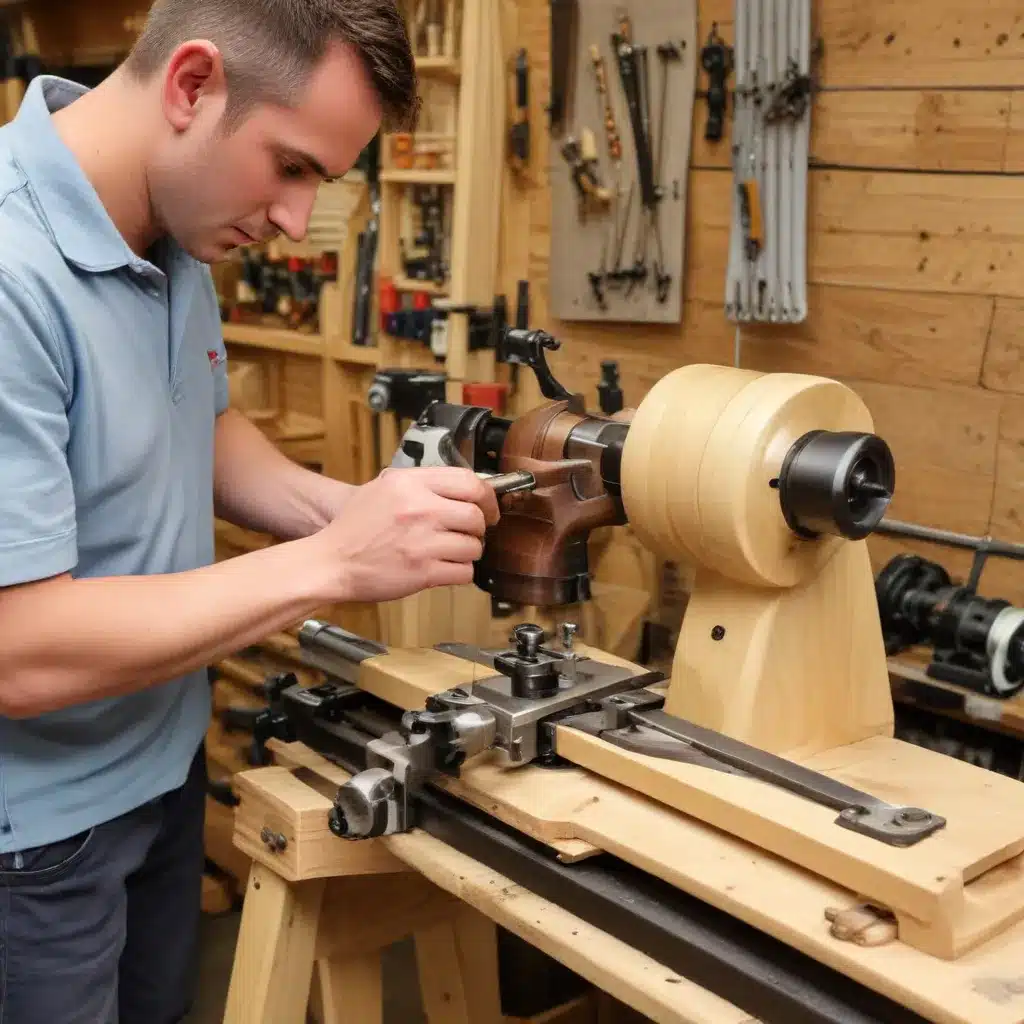
Unlocking the Secrets of Lathe Mastery
As an experienced woodworker and craftsman, I’ve had the privilege of honing my skills on the lathe over many years. The lathe is truly a magnificent tool – an indispensable workhorse that allows us to transform raw wood into stunning, one-of-a-kind pieces. Whether you’re crafting elegant furniture parts, turning delicate bowls, or creating intricate decorative pieces, the lathe is the canvas upon which we bring our creative visions to life.
Yet, for all its power and versatility, the lathe can also be an intimidating piece of equipment, especially for those new to the craft. The sheer array of tools, techniques, and woodworking principles involved in mastering the lathe can seem daunting. But fear not, my fellow woodworkers – with the right guidance and a willingness to experiment, you too can elevate your skills on the lathe and unlock a whole new world of woodturning possibilities.
Mastering the Fundamentals: Lathe Safety and Tool Selection
Before we dive into the more advanced techniques, let’s start with the foundation – safety and tool selection. Woodturning on the lathe can be incredibly rewarding, but it also carries inherent risks that must be taken seriously. The first and most crucial step is to familiarize yourself with the lathe’s safety features and operating procedures. From properly securing the workpiece to maintaining a clean and organized workspace, every precaution must be observed to ensure a safe and productive turning session.
Equally important is selecting the right tools for the job. The world of woodturning tools can seem overwhelming, with a dizzying array of chisels, gouges, skews, and parting tools, each designed for specific tasks. As you begin your lathe journey, focus on mastering a core set of essential tools, such as the spindle gouge, bowl gouge, and parting tool. Invest time in learning how to sharpen and maintain these tools, as their performance is directly tied to the quality of your finished work.
Shaping the Grain: Mastering Spindle and Bowl Turning Techniques
With a solid foundation in safety and tool selection, we can now dive into the heart of woodturning – the techniques that allow us to shape and manipulate the grain of the wood. Spindle turning and bowl turning are two of the most fundamental and versatile woodturning disciplines, and each requires its own set of specialized skills.
In spindle turning, the workpiece is oriented with the grain running parallel to the lathe’s axis. This orientation lends itself well to creating furniture parts, tool handles, and other cylindrical forms. Mastering spindle turning techniques, such as cove cutting, bead forming, and parting off, will equip you with the tools to create elegant, precisely proportioned spindles and other turned components.
Bowl turning, on the other hand, involves working with the grain oriented perpendicular to the lathe’s axis. This technique allows us to craft a wide range of functional and decorative bowls, platters, and vessels. Developing a keen understanding of wood grain patterns, tool control, and finishing techniques will be crucial as you navigate the challenges of bowl turning.
Pushing the Boundaries: Exploring Faceplate and Specialty Turning
As your woodturning skills progress, you’ll undoubtedly find yourself drawn to more advanced and specialized techniques. Faceplate turning, for example, opens up a world of possibilities for creating intricate, one-of-a-kind pieces. By securely mounting the workpiece to a faceplate, you can explore the creation of large platters, deep bowls, and even sculptural forms.
Another exciting area of exploration is specialty turning, which encompasses a diverse range of techniques and projects. From turning segmented pieces to incorporating exotic materials like resin or metal, the possibilities for experimentation and artistic expression are virtually limitless. By pushing the boundaries of what’s possible on the lathe, you’ll not only develop a deeper understanding of the craft but also cultivate your unique style and creative voice.
Embracing Continual Improvement: The Woodturner’s Journey
The beauty of woodturning lies in its endless possibilities for growth and discovery. No matter your skill level, there is always room for improvement, whether it’s mastering a new technique, honing your tool sharpening skills, or experimenting with different wood species and finishes.
Embrace the mindset of a perpetual learner, and seek out opportunities to expand your knowledge and expertise. Attend workshops, join local woodturning clubs, or connect with experienced mentors who can share their insights and inspire you to take your craft to new heights. By constantly challenging yourself and exploring the depths of this versatile medium, you’ll not only elevate your own skills but also contribute to the rich tapestry of the woodturning community.
Conclusion: Unleashing Your Creative Potential on the Lathe
The lathe is a remarkable tool that has the power to transform the way we approach woodworking. By mastering the fundamental techniques, exploring advanced methods, and cultivating a lifelong commitment to learning, you’ll unlock a world of creative potential on the lathe.
Whether you’re a seasoned woodturner or just embarking on your journey, I encourage you to embrace the challenges and joys of this captivating craft. Experiment, push boundaries, and never stop honing your skills. The rewards of woodturning are manifold – from the satisfaction of creating beautiful, functional pieces to the deep sense of connection with the natural world that comes from working with wood.
So, let’s raise our chisels and embark on this extraordinary woodturning adventure together. The lathe awaits, ready to help us bring our visions to life, one revolution at a time. Onward, fellow woodworkers, and may your lathes forever sing with the rhythm of your creativity!

